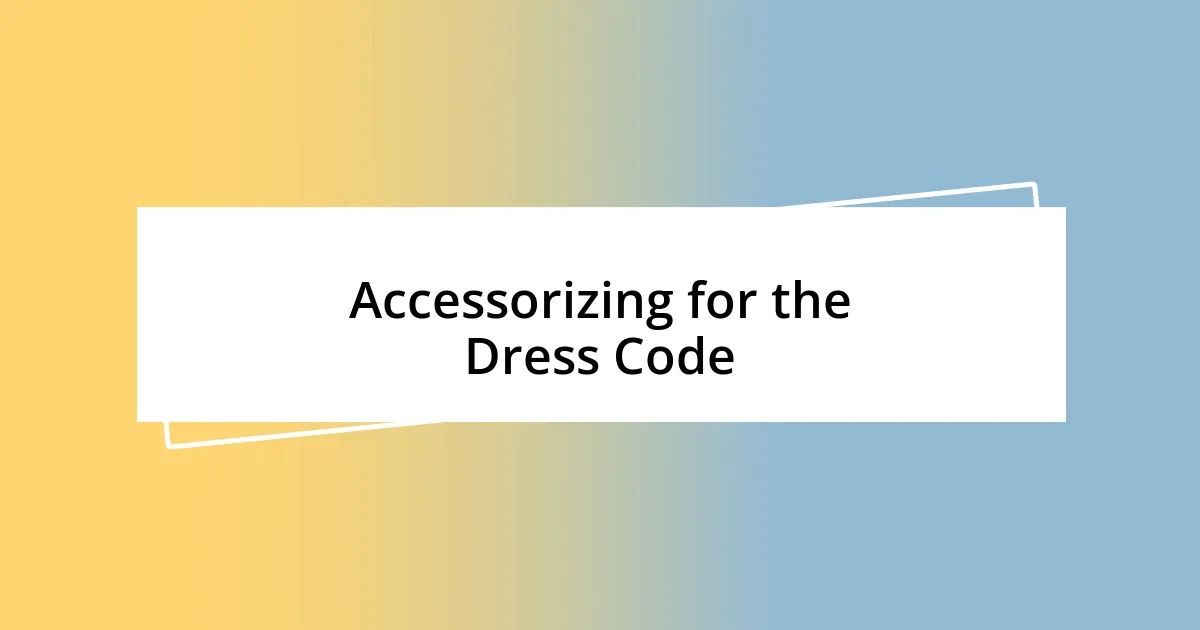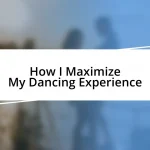Key takeaways:
- Understanding wedding dress codes is crucial as each type reflects the event’s atmosphere; knowing them helps reduce anxiety and ensures appropriate attire.
- The details on the wedding invitation, such as wording and venue, provide essential clues about expected attire.
- Accessorizing and choosing the right fabrics and styles are key to aligning one’s outfit with the dress code while maintaining comfort and personal style.
- Common mistakes include misjudging dress codes, ignoring fabric suitability for the season, and losing personal flair in favor of conformity.

Understanding Wedding Dress Codes
Wedding dress codes can often feel like a confusing puzzle, especially when you receive that beautifully crafted invitation. I remember unwrapping an elegant envelope that read “semi-formal” and feeling a surge of anxiety—what does that even mean? It sparked a flurry of questions in my mind and a search through countless online articles, all aiming to decode the nuances of wedding attire.
Each dress code, whether it’s “black tie,” “cocktail,” or “casual,” comes with its own unwritten rules. For instance, I once attended a “cocktail” wedding where the bride dazzled in a stunning knee-length gown while I opted for a slightly more casual sundress. I felt like I was underdressed compared to her glamour, and it made me realize how crucial it is to truly understand these expectations. How can you feel comfortable and confident if you’re unsure how to dress?
When I finally grasped that the essence of dress codes lies in the vibe of the celebration, it shifted my perspective. The way people dressed for that wedding conveyed the celebration’s formality. It made me wonder: are these codes there to guide us in expressing our individuality while respecting the couple’s vision? Understanding that balance made all the difference, allowing me to approach future weddings with excitement rather than dread.

Types of Wedding Dress Codes
When diving into the various types of wedding dress codes, I found they each have distinct vibes that set the mood for the day. For instance, I vividly remember attending a “black tie” wedding where the formality brought out the best in everyone—tuxedos and elegant gowns creating a sea of sophistication. It was a moment where I felt the weight of expectations, yet the experience was magical, reinforcing my understanding that each code reflects not just attire, but also the atmosphere of the event.
Here’s a quick rundown of typical wedding dress codes you might encounter:
- Black Tie: Formal dresses for women, tuxedos for men.
- Black Tie Optional: Women can choose long gowns or cocktail dresses; men can wear a suit instead of a tuxedo.
- Formal or Black Tie Recommended: Similar to black tie, but there’s a hint of flexibility.
- Cocktail Attire: Short or knee-length dresses for women, smart suits for men.
- Semi-Formal: Dressy outfits like dresses or slacks for women, suits or dress pants for men.
- Casual: Think sundresses or nice slacks for women, khakis and polo shirts for men.
- Beach Formal: Lightweight fabrics; flowing dresses or beachy attire for women, linen suits for men.
Studying these categories has helped me feel more prepared and less anxious when faced with a wedding invite. Knowing what to expect eases the stress of choosing the perfect outfit, allowing me to focus on enjoying the celebration instead.

Evaluating the Wedding Invitation
When evaluating a wedding invitation, the details within can speak volumes about what’s expected from guests. I recall receiving a beautiful invite that hinted at an outdoor garden wedding. The delicate script and choice of colors immediately set a cheerful tone, and I knew right away to consider light fabrics and perhaps a floral print for my outfit. It was a reminder that the invitation isn’t just a call to celebrate; it also offers clues about the atmosphere and dress code.
Moreover, I find that the wording on the invitation can provide valuable context. For instance, when I attended a wedding that labeled its attire as “formal,” the guests showcased elegant gowns and polished suits, creating a sense of unity in our appearances. It made me feel like we were all part of a grand narrative that the couple had crafted for their special day. Conversely, the invitations that included phrases like “festive attire” invited more creativity and fun into our outfit choices, which always excites me!
Finally, don’t underestimate the power of RSVP details. A wedding invitation that includes a specific location, such as a beach or a banquet hall, can significantly influence my outfit decisions. I remember a wedding where the venue was a rustic barn, leading me to choose a blend of comfort and style—think soft cotton and playful patterns. It was practical yet chic, and I felt right at home in the setting. So, each detail on that invitation acts like a roadmap, guiding me toward the perfect look for the celebration ahead.
| Invitation Detail | Implication for Attire |
|---|---|
| Wording (“Formal”) | Elegant gowns and polished suits expected |
| Wording (“Festive Attire”) | Encourages creativity and fun in outfit choices |
| Venue (Beach) | Light fabrics, comfortable footwear are ideal |
| Venue (Rustic Barn) | Comfort and style with soft materials |

Choosing the Right Outfit
Choosing the right outfit for a wedding can truly feel daunting. I’ll never forget the time I miscalculated the dress code for a “beach formal” wedding. Picture me in a gorgeous but heavy long dress, struggling to walk on sand while everyone else floated around in breezy linen and playful prints. It was a lesson learned about the importance of aligning my outfit with the venue and theme.
Another memorable experience was when I attended a cocktail attire wedding. Excitedly, I pulled out a shimmering, knee-length dress adorned with sequins. However, upon arrival, I noticed that most guests opted for more laid-back yet chic styles. I felt a little out of place, so now I always consider the overall vibe while experimenting with elegance and comfort. After all, who wants to feel restricted when celebrating love?
When facing a dress code, I remind myself that my comfort is key. For a recent semi-formal wedding, I chose a flowy midi dress that I could dance in effortlessly. The joy of twirling around the dance floor in something that felt right made the night unforgettable. I often ask myself: how do I want to feel in my outfit? This reflection helps guide my choices, ensuring I’m both stylish and at ease during the celebration.

Accessorizing for the Dress Code
When it comes to accessorizing for specific wedding dress codes, I’ve learned that the right details can elevate an outfit significantly. At a recent “black tie” wedding, I opted for a classic satin clutch and sparkling statement earrings, which really tied my look together. It was amazing how such small additions made me feel more sophisticated and aligned with the glamorous atmosphere, highlighting just how important accessories can be in complementing an outfit.
I’ve also discovered that choosing the right shoes is crucial to nailing the dress code. For a laid-back beach wedding, I remember donning a pair of elegant strappy sandals instead of heels. The ease of walking on the sand felt fantastic, and it allowed me to enjoy the celebration without worrying about wobbling on uneven ground. It reminds me that comfort doesn’t have to sacrifice style; in fact, the right footwear can enhance your confidence and ability to fully engage in the day.
Finally, I never overlook the impact of layering and additional piece. At a winter wedding, I chose a chic shawl that added warmth while still looking stylish. It was such a comforting piece that not only completed my outfit but also sparked conversations with fellow guests who appreciated the thoughtful choice. I always find myself asking: how can I add a personal touch with my accessories that reflects my style while remaining appropriate for the occasion? Finding that balance makes the whole experience more enjoyable and memorable.

Common Dress Code Mistakes
I often cringe at those moments when I’ve missed the mark with dress codes. For instance, there was this charming autumn wedding where I confidently wore a tea-length dress, thinking that my heavy tights would keep me warm. It turned out that most guests went for floor-length gowns and sharper attire, leaving me feeling somewhat underdressed and out of sync with the event. It really struck me that understanding the temperature and attire balance is just as critical as adhering to the dress code itself. Why do we overlook such essentials?
Another mistake I’ve found many people make is ignoring fabric choices. At a summer wedding, I excitedly picked a lovely velvet dress, convinced it would stand out beautifully. While it certainly did, that heavy fabric had me sweating throughout the ceremony. I realized then that the materials we choose can profoundly affect our comfort and overall enjoyment of the day, so it’s worth considering how appropriate the fabric is for the season. Why struggle through discomfort?
Lastly, I often see others overlook the significance of personal style within dress codes. At a recent afternoon garden wedding, I saw a friend in a perfectly acceptable outfit that just didn’t resonate with her flair for bohemian vibes. While she looked lovely, I could see a hint of discomfort in her stance. This made me reflect on how one’s style can sometimes get lost in translation, and I’ve learned that it’s possible to honor the dress code while still remaining authentic to oneself. Isn’t it essential to celebrate love and your unique style simultaneously?

Tips for Adapting Dress Codes
Adapting to different dress codes can be a challenge, but I’ve found that a little research and creativity go a long way. For example, while preparing for a semi-formal wedding, I learned that pairing a simple dress with a tailored blazer instantly elevated my look without overwhelming it. Isn’t it fascinating how the right layering piece can transform an outfit and even your confidence in a matter of minutes?
I remember attending a rustic-themed wedding where I found myself torn between casual and elegant. I decided to wear a chic jumpsuit, balancing both comfort and style. Adding a flower crown gave me a touch of playfulness that matched the vibe perfectly. This experience taught me that the key to adapting is finding inspirational elements in the event’s theme, allowing my outfit to resonate with the overall ambiance.
When facing a formal dress code, I quickly realized the importance of understanding what “formal” truly means for each event. Preparing for a recent black-tie affair, I sought advice from others who had attended similar weddings and learned that some opted for richer colors and textures. By choosing a deep emerald gown that caught the light beautifully, I not only adhered to the dress code but also felt a spark of excitement wearing something that felt like me. How can we navigate such nuances while feeling genuine and stylish? It’s all about striking a balance between the guidelines and personal expression.














